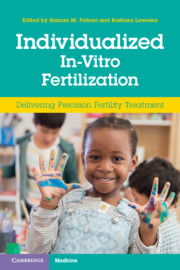Book contents
- Individualized In-Vitro Fertilization
- Individualized In-Vitro Fertilization
- Copyright page
- Contents
- Contributors
- Chapter 1 Individualized Ovarian Stimulation for Normal and High Responders
- Chapter 2 Individualized Ovarian Stimulation in Patients with Advanced Maternal Age and Premature Ovarian Aging
- Chapter 3 Individualized Oocyte Maturation
- Chapter 4 Individualized Luteal Phase Support
- Chapter 5 Individualized Management of Male Infertility
- Chapter 6 Individualized Fertilization Technique in the IVF Laboratory
- Chapter 7 Individualized Genetic Testing
- Chapter 8 Individualized Embryo Selection
- Chapter 9 Preparation for Optimal Endometrial Receptivity in Cryo Cycles
- Chapter 10 Individualized Immunological Testing in Recurrent Implantation Failure
- Chapter 11 Individualized Embryo Transfer
- Index
- Plate Section (PDF Only)
- References
Chapter 5 - Individualized Management of Male Infertility
Published online by Cambridge University Press: 12 February 2021
- Individualized In-Vitro Fertilization
- Individualized In-Vitro Fertilization
- Copyright page
- Contents
- Contributors
- Chapter 1 Individualized Ovarian Stimulation for Normal and High Responders
- Chapter 2 Individualized Ovarian Stimulation in Patients with Advanced Maternal Age and Premature Ovarian Aging
- Chapter 3 Individualized Oocyte Maturation
- Chapter 4 Individualized Luteal Phase Support
- Chapter 5 Individualized Management of Male Infertility
- Chapter 6 Individualized Fertilization Technique in the IVF Laboratory
- Chapter 7 Individualized Genetic Testing
- Chapter 8 Individualized Embryo Selection
- Chapter 9 Preparation for Optimal Endometrial Receptivity in Cryo Cycles
- Chapter 10 Individualized Immunological Testing in Recurrent Implantation Failure
- Chapter 11 Individualized Embryo Transfer
- Index
- Plate Section (PDF Only)
- References
Summary
Approximately 8–15 percent of couples are unable to conceive after 1 year of unprotected intercourse, and they are thereby considered infertile; this problem has become a global health concern, affecting roughly 187 million couples worldwide (). Male factor infertility occurs in 40–50 percent of the infertile couples, being solely responsible in approximately 20 percent of cases and in association with a female factor in another 20–30 percent. Although the male factor infertility is traditionally defined by the presence of abnormal semen parameters, it can nowadays be considered even when the seminal analysis is normal but with abnormal functional sperm tests ().
- Type
- Chapter
- Information
- Individualized In-Vitro FertilizationDelivering Precision Fertility Treatment, pp. 50 - 64Publisher: Cambridge University PressPrint publication year: 2021

